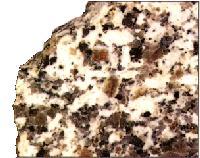Distinctive
features:
Granular,
composed of feldspar and quartz, with
accessory biotite and muscovite. One feldspar
may eb flesh coloured, whiel the other is
white. The white fledspar may show twinning
striations characteristic of plagioclase; the
other feldspar is almost certainly
orthoclase. The quartz appears as grey glassy
grains. Biotite is black and muscovite is
white or silvery and both shine or sparkle by
reflected light.
Colour:
As above.
Texture and
granularity:
Granular,
coarse-grained, often porphyritic with
feldspar crystals up to 10 cm (4 in).
Composition:
Orthoclase
feldspar is always greater than plagioclase.
if plagioclase is dominant the rock is
probably a qaurtz sdiorite. White to salmon
pink orthoclase feldspar megacrusts, set in a
ground mass of glassy quartz. White/pink
orthoclase, white plagioclase, black viotite
and silvery muscovite. Accessory minerals
incldue gold-coloured pyrites and silvery
black magnetite.
Field
associations:
Associated with
fold mountains (e.g. Himalayas, Andes, Urals,
Appalachians and Rockies). Granites often
mark poisiton of ancient fold mountain
system.
Variations:
Numerous. Immense variation in granularity
and colour - extremely coarse pegmatite,
fine-grained microgranite, saccharoidal
oplite. Orbicular has composite minerals
arranged in ovoid or spherical bodies.





![]()

![]()




